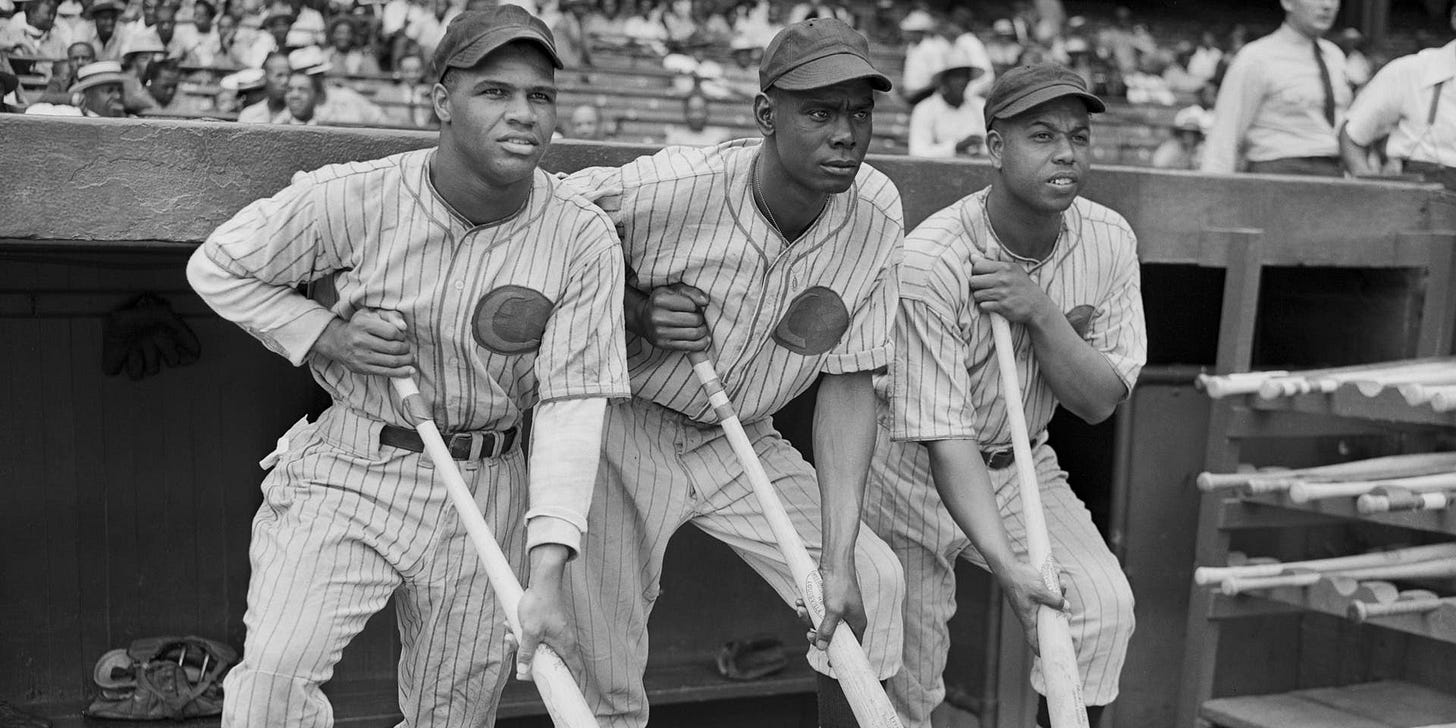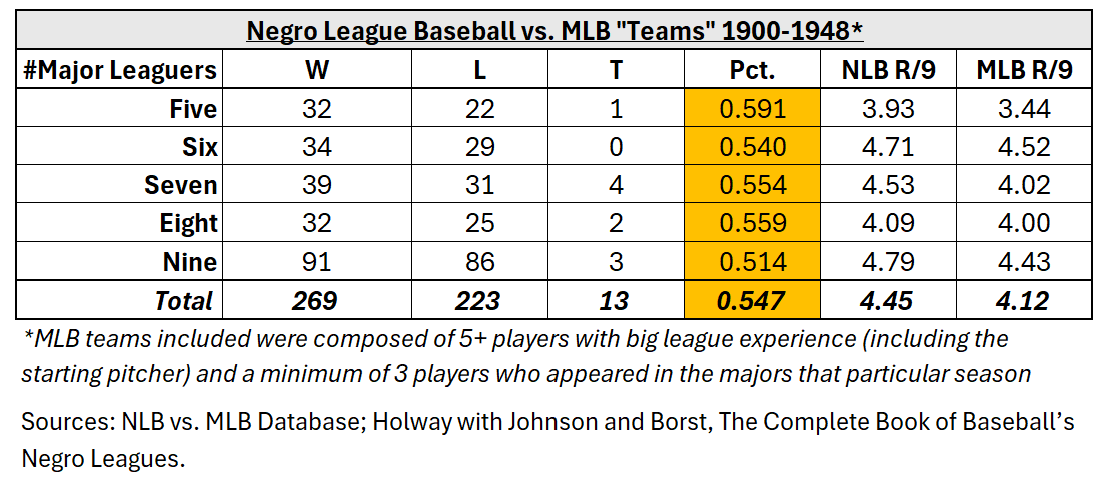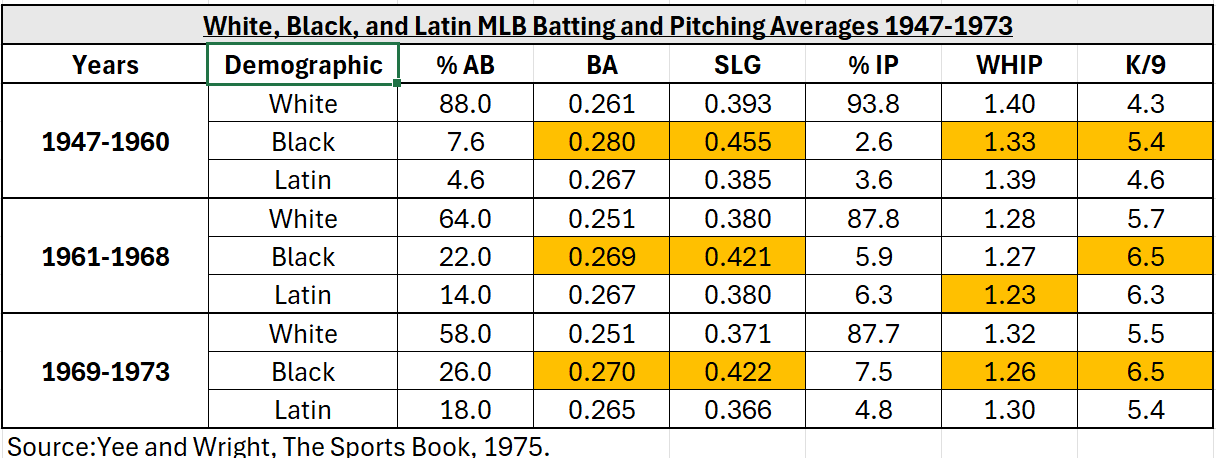Yes, Negro Leagues Were Major Leagues...and They Were Really Good
At long last, they and their players are finally getting the credit they deserve.
I’m somewhat embarrassed to say that it never truly phased me that Negro League statistics were not included in the Major League Baseball record books. It’s not because I didn’t believe they should be, I guess it just never really occurred to me. I knew of the Negro Leagues and many of its legendary players, but when it came to thinking about the all-time greats, I guess I just mistakenly overlooked them. It is for reasons like this that last Wednesday, May 29th, when MLB added the statistics of over 2,300 Negro Leaguers into its records, was such an important day in the sport. Anyone with at least some knowledge of the history of baseball surely knows of Negro league baseball, which consisted of seven major baseball leagues spanning from 1920-19481. However, until last week they were viewed in the same way that sadly so many other aspects of life in that era were viewed; separate but “equal”. Keeping these stats separate, though, gave the appearance of inequality. Hence why when Baseball made this announcement, they phrased it as “elevating” Negro League stats. It made the Negro Leagues appear as a “lesser” league to the American and National Leagues of old. This is a wild misconception. While most applaud this move, some traditionalists still hold that the White Major Leagues were superior in this era and should be considered the “true” major leagues. But research has proven Negro League Baseball was of equal (if not in some ways or eras, better) caliber to the American and National Leagues that made up Major League Baseball. There is no reason Negro League stats should not be included alongside American and National League stats. I will break down why and then look into some records that were impacted the most by this long overdue update.
The Negro League Is Not the Only “Other” League
There hasn’t always been the MLB we know and love today. In fact, until 2000, the American and National Leagues were actually legally separate entities. Technically, Major League Baseball is merely an organization, while “Major League” is a designation. In other words, while MLB is “Major League”, "Major League” is not necessarily MLB. While the American and National Leagues, (and since 2000, the MLB), have been the most popular, successful, and long-lasting American professional baseball leagues, Major League Baseball actually recognizes six major leagues dating back to 1876: the American Association (1882-1891), Union Association (1884), Players’ League (1890), and Federal League (1914-1915), along with the National and American Leagues we all know (formed in 1876 and 1901, respectively). These have been recognized since 1969. So, the inclusion of other leagues aside from the American and National is not unprecedented.
Myth - The Major Leagues Were Better Than the Negro Leagues
One may think that because the Negro Leagues were never considered “major” leagues and were less popular, that they were of inferior quality. They would be wrong. From the onset of the American League through the final year of the second Negro National League in 1948, African American clubs posted a 316-283-21 record versus White major league teams and big-league aggregations, good for a winning percentage of .527.2 Thats a record that in today’s game has a good shot of making the playoffs (and even may run away with a division in some years now)! Against intact National, American, and Federal League teams, Black teams went of 47-60-8 (.443). From the birth of the Negro National League in 1920 through 1924, African American teams went 29-31-2 (.484) in head-to-head competition against aforementioned White squads.3 However, Black teams likely won far more games than the records show, as the White press was often not inclined to publicize Black athletic success. The table below shows the record of Negro League clubs against White professional clubs based on how many major league players were on the White team.
Negro League Teams Played Less Games - So What?
While the MLB has played a 162-game schedule since 1961, Negro League teams played far fewer, typically between 60 and 80 official games. I have heard this as an argument against including Negro League stats in the MLB records, largely citing MLB’s minimum standards of playing time for inclusion in season and career records. This pertains mostly to rate-stats, like Batting Average, OPS, and ERA, which can be artificially inflated (or deflated) by a smaller sample of play. Anyone remember the year 2020? Oh yeah, a global pandemic shuttered sports for months and forced baseball into a truncated 60-game season. Are those records official? Yup! Prior to 1962, the American and National Leagues played 154 games. Those records are official. Heck, in the first year of the American League, teams only played 140 games! Through some research, I found that 60 games is a fairly good proxy for how a player will perform over the entirety of the season. Based on players who played at least 135 games between 1947 and 1951 (the five years post-integration), the average OPS (On-base % + Slugging %) in their first 60 games was 0.851, compared to 0.833 over their last 135 games - a mere 0.018-point difference.4 The average absolute difference in OPS for these players was 0.060. In fact, there is a correlation of 0.743 between first-60 and last-135 OPS, meaning first 60 game OPS explains over 55% of end-of-season OPS. We should also consider that the MLB first-60-game OPS numbers may be lower due to cooler and less-favorable batting weather in the early spring months. This is something Negro League teams may not have had to deal with as much being a bit more concentrated in the south, and likely playing a lesser number of their games in the early spring. So if anything, Nego League rate-stats during their shorter season could arguably be closer to that of a full MLB length season than we would expect from this comparison.
Myth - MLB Players Were Better
Putting aside the fact that we already discussed how Negro League teams regularly beat White professional teams, this is just utterly false. The table below shows MLB batting and pitching averages for Black and Latin players (who would have been forced to the Negro Leagues prior to 1947) against their White counterparts in the years following integration. Black players led in all but one category (Latin pitchers led WHIP in 1961-1968)
Think about some of the legendary players we witnessed during this time. Players like Willie Mays, Hank Aaron, and Roberto Clemente would have all been in the Negro Leagues if not for integration. Do we ever challenge the ability of these players? No, we consider them to be on the short list of all-time greats. Due to the lesser number of games, counting stats for Negro League players, like Home Runs, Strikeouts and RBI’s, are far lower. This should not take away from how we view these players in terms of those stats, however. Josh Gibson, nicknamed “The Black Babe Ruth”, was possibly the greatest hitter not only in the Negro Leagues, but in the history of Baseball. Over just 602 official games, Gibson hit 166 home runs and drove in 733 RBI’s. Had he maintained that rate playing as many games as the Home Run King Barry Bonds, he would have hit 823 dingers. In fact, he would have only needed 2,768 games to surpass Bonds (who played 2,986) games, which would rank as the 30th-most all-time games played, just ahead of Derek Jeter. Regarding RBI’s, Gibson was even more impressive. His rate of 29.0 RBIs per 100 Plate Appearances are the most all time, blowing past the previous leader Babe Ruth who had 20.8. In fact, in order to surpass all-time RBI leader Hank Aaron, Gibson would have only required 1,887 games. For comparison, Aaron played 410 more games! Maybe now people will learn to recognize Josh Gibson for what he truly was; arguably the greatest hitter of all time. Instead of saying Negro League stats aren’t as impressive because they didn’t play against guys like Babe Ruth and Cy Young, maybe we should say Ruth and Young weren’t as impressive because they didn’t face guys like Gibson?
A Shakeup in the Record Books
Now that it is clear Negro League stats should be viewed equally in the professional baseball record books, what stats saw the biggest leaderboard shakeup? The batting average leaderboard got the biggest overhaul.
Five Negro Leaguers broke into the top-10, with Josh Gibson surpassing the longtime leader, Ty Cobb. Career OPS (On-base% + Slugging%) also saw 5 players break into the top-10. Josh Gibson topped that list as well.
Some other notable leaderboard changes include Dave Brown now being third all-time in career ERA (2.24), and Satchel Paige third all-time in single season ERA when he tossed a 1.01 for the Kansas City Monarch’s in 1944. The second-best single season batting average now goes to Charlie “Chino” Smith, who hit .451 in 1921 for the New York Lincoln Giants. Who tops that list? None other than Josh Gibson, whose .466 average in 1943 leads the way. Barry Bonds remains the king of single season slugging percentage when he slugged .609 in 2004 and .582 in 2002, but Josh Gibson and Chino Smith are now behind him at .564 and .551, respectively.5
I tip my cap to Baseball for finally making things right in the record books. This was an immensely daunting research endeavor, and I commend all of their work. While we can never fully make up for the injustices of our ancestors, this represents one small, yet incredibly meaningful effort to right the wrongs of the past. Thank you, MLB.
Negro National League (I) (1920–1931), Eastern Colored League (1923–1928), American Negro League (1929), East–West League (1932), Negro Southern League (1932), Negro National League (II) (1933–1948), Negro American League (1937–1960 or so)
Negro Leagues = Major Leagues | Baseball-Reference.com
Negro Leagues = Major Leagues | Baseball-Reference.com
Stats via Stathead Player Batting Span Stats Finder - Baseball | Stathead.com
The MLB-Negro Leagues stat change: What happened, and why? - The Athletic (nytimes.com)






